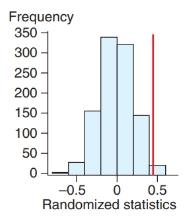
Sports and Extraversion (Example 5) Are students who participate in sports more extraverted than those who do not? A random sample of students at a small university were asked to indicate whether they participated in sports (yes or no) and to rate their level of extraversion. Extraverts are outgoing, are talkative, and don’t mind being the center of attention. Students were asked whether they agreed with the statement that they were extraverts, using a scale of 1 to 5 with 1 meaning “strongly disagree” and 5 meaning “strongly agree.” There were 51 students who participated in sports and 64 who did not.

The
sports was 3.618, and the mean for those who did not participate was 3.172, a difference of 0.446 point. To determine whether the mean difference was significant, we performed a randomization test to test whether the mean extraversion level was greater for athletic students.
a. The histogram shows the results of 1000 randomizations of the data. In each randomization, we found the mean difference between two groups that were randomly selected from the combined group of data: the combined data for the sporty and nonsporty. Note that, just as you would expect under the null hypothesis, the distribution is centered at about 0. The red line shows the observed sample mean difference in extraversion for the sporty minus the nonsporty. From the graph, does it look like the observed mean difference is unusual for this data set? Explain.
b. The software output gives us the probability of having an observed difference of 0.446 or more. (See the column labeled “Proportion=7 Observed”). In other words, it gives us the right tail area, which is the
c. Using a significance level of 0.05, can we reject the null hypothesis that the means are equal?
d. If you did not have the computer output, explain how you would use the histogram to get an approximate

Want to see the full answer?
Check out a sample textbook solution
Chapter 13 Solutions
EP INTRODUCTORY STATISTICS-MYSTATLAB
Additional Math Textbook Solutions
A Problem Solving Approach To Mathematics For Elementary School Teachers (13th Edition)
APPLIED STAT.IN BUS.+ECONOMICS
Elementary Statistics: Picturing the World (7th Edition)
Algebra and Trigonometry (6th Edition)
Precalculus: Mathematics for Calculus (Standalone Book)
- Name Harvard University California Institute of Technology Massachusetts Institute of Technology Stanford University Princeton University University of Cambridge University of Oxford University of California, Berkeley Imperial College London Yale University University of California, Los Angeles University of Chicago Johns Hopkins University Cornell University ETH Zurich University of Michigan University of Toronto Columbia University University of Pennsylvania Carnegie Mellon University University of Hong Kong University College London University of Washington Duke University Northwestern University University of Tokyo Georgia Institute of Technology Pohang University of Science and Technology University of California, Santa Barbara University of British Columbia University of North Carolina at Chapel Hill University of California, San Diego University of Illinois at Urbana-Champaign National University of Singapore…arrow_forwardA company found that the daily sales revenue of its flagship product follows a normal distribution with a mean of $4500 and a standard deviation of $450. The company defines a "high-sales day" that is, any day with sales exceeding $4800. please provide a step by step on how to get the answers in excel Q: What percentage of days can the company expect to have "high-sales days" or sales greater than $4800? Q: What is the sales revenue threshold for the bottom 10% of days? (please note that 10% refers to the probability/area under bell curve towards the lower tail of bell curve) Provide answers in the yellow cellsarrow_forwardFind the critical value for a left-tailed test using the F distribution with a 0.025, degrees of freedom in the numerator=12, and degrees of freedom in the denominator = 50. A portion of the table of critical values of the F-distribution is provided. Click the icon to view the partial table of critical values of the F-distribution. What is the critical value? (Round to two decimal places as needed.)arrow_forward
- A retail store manager claims that the average daily sales of the store are $1,500. You aim to test whether the actual average daily sales differ significantly from this claimed value. You can provide your answer by inserting a text box and the answer must include: Null hypothesis, Alternative hypothesis, Show answer (output table/summary table), and Conclusion based on the P value. Showing the calculation is a must. If calculation is missing,so please provide a step by step on the answers Numerical answers in the yellow cellsarrow_forwardShow all workarrow_forwardShow all workarrow_forward
 Glencoe Algebra 1, Student Edition, 9780079039897...AlgebraISBN:9780079039897Author:CarterPublisher:McGraw Hill
Glencoe Algebra 1, Student Edition, 9780079039897...AlgebraISBN:9780079039897Author:CarterPublisher:McGraw Hill College Algebra (MindTap Course List)AlgebraISBN:9781305652231Author:R. David Gustafson, Jeff HughesPublisher:Cengage Learning
College Algebra (MindTap Course List)AlgebraISBN:9781305652231Author:R. David Gustafson, Jeff HughesPublisher:Cengage Learning Holt Mcdougal Larson Pre-algebra: Student Edition...AlgebraISBN:9780547587776Author:HOLT MCDOUGALPublisher:HOLT MCDOUGAL
Holt Mcdougal Larson Pre-algebra: Student Edition...AlgebraISBN:9780547587776Author:HOLT MCDOUGALPublisher:HOLT MCDOUGAL



